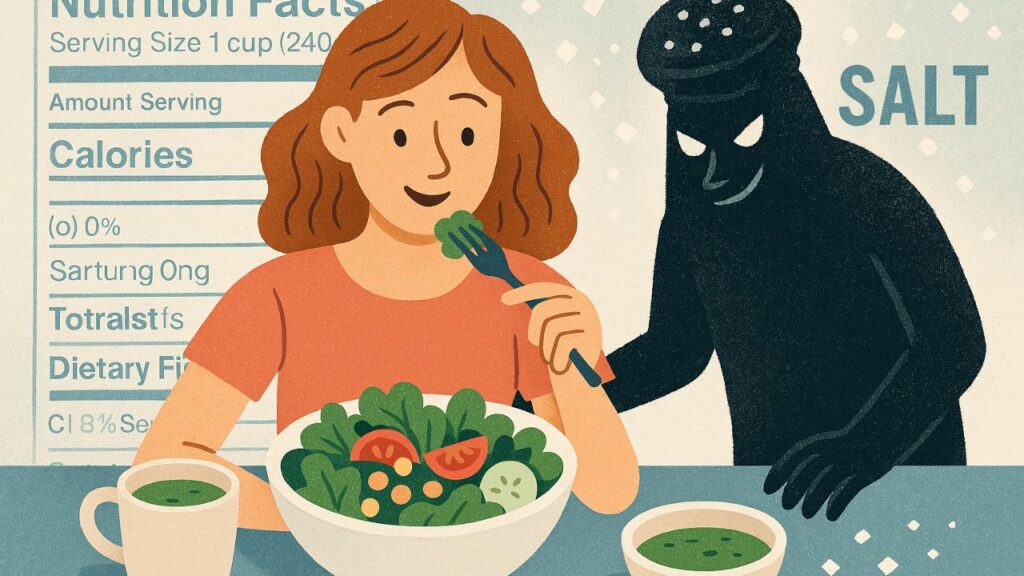Introduction
Feeling bloated after meals or noticing your blood pressure creeping up despite eating “healthy”? The sneaky culprit could be sodium, hiding in plain sight in your everyday foods. While most people think of salt as the shaker on the table, sodium lurks in processed snacks, restaurant dishes, and even seemingly innocent “health foods.” Excessive sodium intake is linked to serious health risks, yet it’s easy to consume too much without realizing it.
This guide dives deep into where sodium hides, how it impacts your body, and practical ways to cut back—without sacrificing flavor. Whether you’re aiming to lower blood pressure or simply feel better, understanding sodium is the first step to taking control of your health.
Understanding Sodium
What is Sodium?
Sodium is a vital mineral and electrolyte that keeps your body running smoothly. It regulates fluid balance, supports nerve signals, and ensures muscles, including your heart, function properly. Found naturally in some foods like celery and beets, sodium is also added to many processed items for flavor and preservation.
Difference Between Salt and Sodium
Here’s the confusion buster: salt and sodium aren’t the same. Table salt is roughly 40% sodium and 60% chloride. When health guidelines or food labels mention sodium, they’re talking about just the sodium portion, measured in milligrams (mg). For example, one teaspoon of salt contains about 2,300 mg of sodium.
Why Your Body Needs Sodium (in Moderation): Your body relies on sodium to maintain fluid balance, transmit nerve impulses, and contract muscles. Without enough, you might feel fatigued or dizzy. But here’s the catch: most people consume far more than needed. The average American eats about 3,400 mg of sodium daily—double the recommended amount—often without realizing it.
How Sodium Affects the Body
Sodium and Blood Pressure
High sodium intake is a major driver of hypertension (high blood pressure). Sodium pulls water into your bloodstream, increasing blood volume and putting extra strain on blood vessel walls. A 2019 study in The Lancet found that reducing sodium intake by 3,000 mg daily could lower blood pressure significantly, even in people without hypertension.
Impact on the Heart and Kidneys
Over time, high blood pressure stresses the heart, increasing the risk of heart disease and heart failure. The kidneys, tasked with filtering excess sodium, also take a hit. Chronic high sodium can impair kidney function, potentially leading to kidney disease, especially in those already at risk.
Fluid Retention and Bloating
Ever feel puffy after a salty meal? Sodium attracts water, causing fluid retention that leads to swollen fingers, tight rings, or a bloated belly. This isn’t just uncomfortable—it’s a sign your body’s struggling to balance fluids.
Long-Term Health Risks of High Sodium Intake
Excess sodium doesn’t just cause short-term issues. Over years, it can contribute to:
- Heart failure: Strained heart muscles weaken over time.
- Stroke: High blood pressure damages blood vessels, raising stroke risk.
- Kidney disease: Overworked kidneys lose efficiency.
- Osteoporosis: Sodium may leach calcium from bones, weakening them.
- Stomach cancer: Some studies link high sodium to increased risk.
Where Sodium Hides in Your Diet
- Processed and Packaged Foods: The biggest sodium culprit? Processed foods, which account for over 70% of sodium intake in most diets. Frozen pizzas, deli meats, canned soups, and snack foods like chips and crackers are often loaded with sodium to enhance taste and shelf life.
- Restaurant and Takeout Meals: Restaurant meals, from fast food to fine dining, are notorious for sky-high sodium levels. A single entrée, like a burger with fries or a stir-fry, can exceed your daily sodium limit. Even “healthy” options, like salads with dressing, can pack 1,000 mg or more per serving.
- Sauces, Condiments, and Canned Goods: Condiments are sodium landmines. One tablespoon of soy sauce can have 900 mg, while ketchup, barbecue sauce, and salad dressings aren’t far behind. Canned goods, like beans or vegetables, often use sodium as a preservative, with a single serving hitting 400–800 mg.
- Sneaky Culprits: Bread, Cheese, and Breakfast insidious: Surprised? Foods like bread, cheese, and cereals don’t taste salty but add up fast because we eat them often. A single slice of bread can have 150–200 mg of sodium, and a bowl of cereal might hit 300 mg before you add milk.
- Sweet Foods With Surprising Sodium Levels: Even desserts can betray you. Packaged cookies, cakes, and instant pudding mixes often contain sodium as a preservative or leavening agent (think baking soda). That “sweet” treat might sneak in 100–200 mg per serving.
Recommended Sodium Intake
What Health Experts Say : The American Heart Association (AHA) recommends an ideal limit of 1,500 mg of sodium per day for most adults, with an upper cap of 2,300 mg (about one teaspoon of salt). Yet, most people far exceed this, often unknowingly.
Daily Limits for Different Age Groups: Sodium needs vary by age and health status:
- Children 1–3: 1,000 mg
- Children 4–8: 1,200 mg
- Teens 9–13: 1,500 mg
- Adults and teens 14+: 1,500–2,300 mg, depending on health conditions like hypertension or kidney issues
Pregnant women and older adults may need tailored guidance from a doctor.
How to Spot Hidden Sodium
- Reading Nutrition Labels: Nutrition labels are your best defense. Check the sodium content per serving and the % Daily Value (DV). A DV of 5% or less is low; 20% or more is high. For example, a soup with 800 mg per serving (35% DV) is a red flag.
- Understanding Serving Sizes: Labels can trick you. A “low-sodium” snack might list 140 mg per serving, but if the bag contains three servings—and you eat it all—you’re at 420 mg. Always multiply sodium by the number of servings you actually consume.
Ingredients That Signal Sodium Overload
Spot these on ingredient lists, and proceed with caution:
- Monosodium glutamate (MSG)
- Sodium bicarbonate (baking soda)
- Sodium nitrate or nitrite
- Disodium phosphate
- Sodium benzoate
Tips to Cut Back on Sodium
Cook More at Home: Home-cooked meals give you full control. Batch-prep staples like rice, grilled chicken, or roasted veggies to avoid relying on sodium-heavy takeout. Bonus: it’s budget-friendly.
Use Herbs and Spices Instead of Salt
Ditch the salt shaker for bold flavors like:
- Fresh herbs: basil, cilantro, rosemary
- Spices: cumin, paprika, turmeric
- Aromatics: garlic, onion, ginger
- Citrus: lemon zest, lime juice
Try blends like Italian seasoning or chili powder for instant flavor.
Choose Fresh or Frozen Over Canned : Fresh produce and meats are naturally low in sodium. Frozen fruits and veggies are a close second—just avoid those with added sauces or seasonings. For example, frozen peas have about 10 mg per cup, while canned peas can hit 300 mg.
Rinse Canned Foods: Can’t avoid canned goods? Drain and rinse beans, corn, or tuna to slash sodium by up to 40%. Better yet, look for “no salt added” versions.
Opt for “Low Sodium” or “No Salt Added” Products: From broths to crackers, low-sodium options are widely available. For instance, regular chicken broth might have 800 mg per cup, while low-sodium versions drop to 50 mg.
The Truth About Sea Salt, Pink Salt, and Other Alternatives
- Are They Healthier?: Sea salt, pink Himalayan salt, and kosher salt are often marketed as “natural” or “healthier.” Truth is, they contain roughly the same sodium by weight as table salt. Pink salt may have trace minerals like magnesium, but not enough to make a meaningful health impact.
- Marketing vs Reality: Fancy packaging can mislead. A 2020 analysis in Nutrients found no significant nutritional advantage to specialty salts over regular table salt for most people. Your body processes sodium the same way, regardless of the source.
Signs You May Be Eating Too Much Sodium
Physical Symptoms to Watch Out For
Your body often signals sodium overload with:
- Persistent thirst, even after drinking water
- Swelling in hands, feet, or ankles
- Frequent headaches or dizziness
- Bloating that lingers
- Elevated blood pressure readings at home
What Your Doctor Might Look For
During checkups, doctors may monitor:
- Blood pressure: Consistently above 120/80 mmHg could indicate sodium sensitivity.
- Kidney function: Blood tests like creatinine levels assess kidney health.
- Electrolyte balance: Sodium levels in bloodwork can reveal imbalances.
Making Lasting Changes
Small Steps That Add Up
Cutting sodium doesn’t mean bland food. Start small:
- Swap one processed snack for fruit or unsalted nuts.
- Use half the sauce packet in takeout meals.
- Try one new low-sodium recipe weekly.
These tweaks compound over time, lowering your intake without feeling restrictive.
How to Train Your Taste Buds
Your taste buds adapt to less salt in about 2–3 weeks. Gradually reduce sodium in cooking and avoid processed foods. Soon, you’ll crave less salt and notice natural flavors more. For example, try roasting vegetables with olive oil and herbs instead of salted seasoning mixes.
Conclusion
Sodium isn’t evil—it’s essential in small doses. But with hidden sodium lurking in processed foods, restaurant meals, and even sweet treats, it’s easy to overdo it. The good news? You can outsmart sodium with simple strategies: read labels, cook at home, and embrace bold, salt-free flavors. By making small changes, you’ll protect your heart, kidneys, and overall health while still enjoying delicious meals. Start today—your body will thank you.
FAQs
How do I know if I’m eating too much salt?
Look for signs like bloating, thirst, swelling, or high blood pressure. Track your meals for a few days using an app like MyFitnessPal to spot sodium sources.
Is pink Himalayan salt better for me?
It’s not significantly healthier. Pink salt has trace minerals but the same sodium content as table salt, so it impacts your body similarly.
Can drinking water balance out high sodium?
Water helps your kidneys flush sodium, but it’s not a cure-all. Focus on eating less sodium to avoid overloading your system.
What are some low-sodium snacks?
Try fresh fruit, unsalted nuts, air-popped popcorn, hummus with veggies, or plain Greek yogurt with berries.
Should athletes worry about cutting salt?
Athletes losing sodium through sweat may need slightly more, but overdoing it can still harm. Consult a dietitian for personalized advice.
Visit Our Social Media : Facebook, Youtube
Visit Our Store: Store


A big thanks for providing the details about where sodium hides in our food and specially how to identify sodium is the biggest help.
Pingback: Is Soya Chaap the Future of Plant Protein?